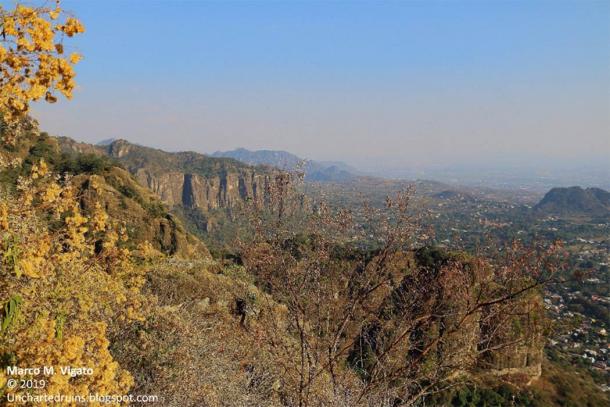Nestled in a sacred valley, at an altitude of about 1,700 meters (5,560 feet) above sea level, to the south of Mexico City, lies the town of Tepoztlán. The surrounding landscape has been shaped by millions of years of volcanic eruptions and erosion. Due to its unusually mild climate and the presence of many caves in the mountains, the area around Tepoztlán has been continuously inhabited for at least the past 10,000 years. The Aztecs held it sacred and built a temple there in homage to its eponymous deity Tepoztecatl. In more recent years, Tepoztlán has become associated with a large number of UFO sightings and other unexplained phenomena, which keep adding to the mystery of the place.

The Town of Tepoztlán and the sacred valley. (Image: © Marco Vigato)
During the 1970’s, Tepoztlán was visited by the Peruvian researcher Daniel Ruzo, discoverer of Marcahuasi, who was drawn to the area by the presence of curious rock formations that he believed were the legacy of a lost civilization once spanning the entire Globe. Ruzo spent the last years of his life in Tepoztlán, exploring and documenting its mysterious mountains and the giant figures carved into their rocks, until the time of his death in 1991.
Daniel Ruzo’s Extraordinary Discoveries
The name of Daniel Ruzo was made famous by his discovery of Marcahuasi and its hundreds of mysterious rock sculptures in the Andes of Peru. Born in Lima in 1900, Ruzo conducted his first expedition to the Meseta of Marcahuasi in 1952, after being shown by the explorer Kuroki Riva pictures of what appeared to be colossal, albeit very eroded, rock sculptures. Ruzo published his first report on the sculptures of Marcahuasi in 1954. He became convinced that a mysterious culture had been responsible for carving entire mountains and valleys in a symbolic fashion thousands of years ago. He called this culture Masma, after a dream related to him by his friend and explorer Pedro Astete, who described a procession of figures dressed in white robes descending into an underground temple containing the complete records of the lost civilization on thousands of tablets and scrolls. Ruzo considered the Masma to be the true mother civilization of humanity, which perished in a great Flood over 10,000 years ago. Over the following decades, Ruzo would spend countless years and resources in search of more evidence of the Masma culture and its prehistoric temples.
Like this Preview and want to read on? You can! JOIN US THERE ( with easy, instant access ) and see what you’re missing!! All Premium articles are available in full, with immediate access.
For the price of a cup of coffee, you get this and all the other great benefits at Ancient Origins Premium. And – each time you support AO Premium, you support independent thought and writing.
Marco M Vigato , a native of Italy, lives in Mexico City and has traveled extensively across Europe, the Middle East, North Africa, South-East Asia, North and South America. Much of his recent research has focused on the megalithic remains of ancient Mexico and Mesoamerica.
Top Image : The “Mexican Sphinx” near Tlayacapan, surrounded by mountains of the Sacred Valley and the landscape around the town of Tepoztlán. (Image: © Marco Vigato)
Related posts:
Views: 0
 RSS Feed
RSS Feed

















 October 15th, 2020
October 15th, 2020  Awake Goy
Awake Goy  Posted in
Posted in  Tags:
Tags: 
















